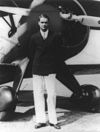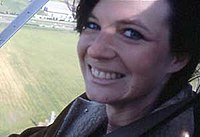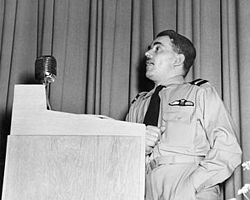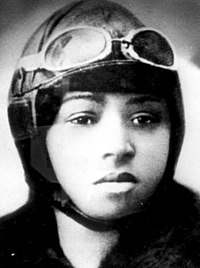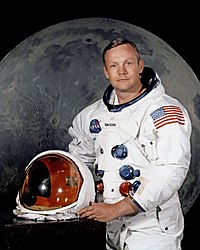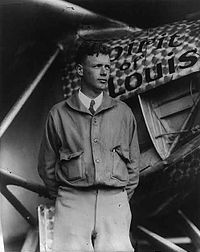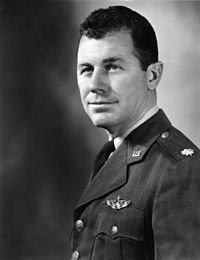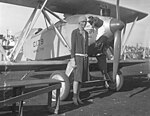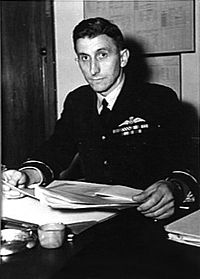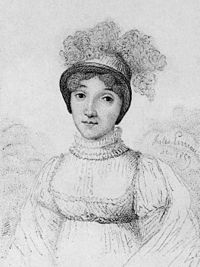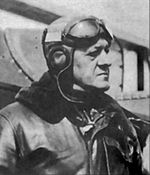Selected biography
Usage
The layout design for these subpages is at Portal:Aviation/Selected biography/Layout.
- Add a new Selected article to the next available subpage.
- Update "max=" to new total for its {{Random portal component}} on the main page.
Despite her surname, Jeana Yeager is not related to Chuck Yeager, the first man to break the sound barrier in level flight.
Air Commodore Sir Frank Whittle (1 June 1907 – 9 August 1996) was a Royal Air Force officer and was one of the inventors of jet propulsion. By the end of the war, Whittle's efforts resulted in engines that would lead the world in performance through the end of the decade.Born in Earlsdon, Coventry, England on June 1, 1907, Whittle left Leamington College in 1923 to join the Royal Air Force (RAF). Through his early days as an Aircraft apprentice he maintained his interest in the Model Aircraft Society where he built replicas, the quality of which attracted the eye of his commanding officer, who was so impressed that he recommended Whittle for the Officer Training College at Cranwell in Lincolnshire in 1926, a rarity for a "commoner" in what was still a very class-based military structure. A requirement of the course was that each student had to produce a thesis for graduation. Whittle decided to write his thesis on future developments in aircraft design, in which he described what is today referred to as a motorjet.
Whittle and Hans von Ohain met after the war and initially Whittle was angry with him as he felt Ohain had stolen his ideas. Ohain eventually convinced him that his work was independent and after that point the two became good friends.
Elbert Leander "Burt" Rutan (born June 17, 1943 in Estacada, Oregon) is an American aerospace engineer noted for his originality in designing light, strong, unusual-looking, energy-efficient aircraft. He is most famous for his design of the record-breaking Voyager, which was the first plane to fly around the world without stopping or refueling, and the suborbital rocket plane SpaceShipOne, which won the Ansari X-Prize in 2004.
Elizabeth 'Bessie' Coleman (January 26, 1892 – April 30, 1926), popularly known as "Queen Bess", was the first African American (male or female) to become an airplane pilot, and the first American of any race or gender to hold an international pilot license. Growing up in Chicago, she heard tales of the world from pilots who were returning home from World War I. They told stories about flying in the war, and Coleman started to fantasize about being a pilot. She could not gain admission to American flight schools because she was black and a woman. No black U.S. aviator would train her either. Coleman took French language class at the Berlitz school in Chicago, and then traveled to Paris on November 20, 1920. Coleman learned to fly in a Nieuport Type 82 biplane. Neil Armstrong (born August 5, 1930) is a former American astronaut, test pilot, university professor, and United States Naval Aviator. He was the first person to set foot on the Moon. His first spaceflight was aboard Gemini 8 in 1966, for which he was the command pilot. On this mission, he performed the first manned docking of two spacecraft together with pilot David Scott. Armstrong's second and last spaceflight was as mission commander of the Apollo 11 moon landing mission on July 20, 1969. On this mission, Armstrong and Buzz Aldrin descended to the lunar surface and spent 2.5 hours exploring while Michael Collins orbited. Armstrong is a recipient of the Congressional Space Medal of Honor.Before becoming an astronaut, Armstrong was in the United States Navy and saw action in the Korean War. After the war, he served as a test pilot at the National Advisory Committee for Aeronautics (NACA) High-Speed Flight Station, now known as the Dryden Flight Research Center, where he flew over 900 flights in a variety of aircraft. As a research pilot, Armstrong served as project pilot on the F-100 Super Sabre A and C aircraft, F-101 Voodoo, and the Lockheed F-104A Starfighter. He also flew the Bell X-1B, Bell X-5, North American X-15, F-105 Thunderchief, F-106 Delta Dart, B-47 Stratojet, KC-135 Stratotanker and Paresev. He graduated from Purdue University.
Charles Augustus Lindbergh, Jr. (February 4, 1902 – August 26, 1974), known as "Lucky Lindy" and "The Lone Eagle", was a pioneering United States aviator famous for piloting the first solo non-stop flight across the Atlantic Ocean in 1927, flying from Roosevelt Airfield (Nassau County, Long Island), New York to Paris on May 20-May 21, 1927 in his single-engine aircraft The Spirit of St. Louis.He grew up in Little Falls, Minnesota. Early on he showed an interest in machinery, especially aircraft. After training as a pilot with the Army Air Service Lindbergh took a job as lead pilot of an airmail route in a DeHavilland DH-4 biplane. He was renowned for delivering the mail under any circumstances.
Lindbergh is recognized in aviation for demonstrating and charting polar air-routes, high altitude flying techniques, and increasing aircraft flying range by decreasing fuel consumption. These innovations are the basis of modern intercontinental air travel.
Charles Elwood "Chuck" Yeager (born February 13, 1923) is a retired Brigadier-General in the United States Air Force and a noted test pilot. In 1947, he became the first pilot (at age 24) to travel faster than sound in level flight and ascent.His career began in World War II as a private in the U.S. Army Air Forces. After serving as an aircraft mechanic, in September 1942 he entered enlisted pilot training and upon graduation was promoted to the rank of Flight Officer (WW 2 U.S. Army Air Forces rank equivalent to Warrant Officer) and became a P-51 Mustang fighter pilot. After the war he became a test pilot of many kinds of aircraft and rocket planes. Yeager was the first man to break the sound barrier on October 14, 1947, flying the experimental Bell X-1 at Mach 1 at an altitude of 45,000 ft (13,700 m). Although Scott Crossfield was the first man to fly faster than Mach 2 in 1953, Yeager shortly thereafter exceeded Mach 2.4.[2] He later commanded fighter squadrons and wings in Germany and in Southeast Asia during the Vietnam War, and in recognition of the outstanding performance ratings of those units he then was promoted to Brigadier-General. Yeager's flying career spans more than sixty years and has taken him to every corner of the globe, even into the Soviet Union during the height of the Cold War.

The Reverend John Flynn (25 November 1880 – 5 May 1951) was an Australian Presbyterian minister and aviator who founded the Royal Flying Doctor Service, the world's first air ambulance.
Throughout his ministerial training, Flynn had worked in various then-remote areas through Victoria and South Australia. As well as tending to matters spiritual, Flynn quickly established the need for medical care for residents of the vast Australian outback, and established a number of bush hospitals. By 1917, Flynn was already considering the possibility of new technology, such as radio and the aeroplane, to assist in providing a more useful acute medical service, and then received a letter from an Australian pilot serving in World War I, Clifford Peel, who had heard of Flynn's speculations and outlined the capabilities and costs of then-available planes. Flynn turned his considerable fund-raising talents to the task of establishing a flying medical service.
The first flight of the Aerial Medical Service was in 1928 from Cloncurry. In 1934 the Australian Aerial Medical Service was formed, and gradually established a network of bases nationwide. Flynn remained the public face of the organisation (through name changes to its present form) and helped raise the funds that kept the service operating.
Amelia Mary Earhart (July 24, 1897 – missing as of July 2, 1937), daughter of Edwin and Amy Earhart, was an American aviator and noted early female pilot who mysteriously disappeared over the Pacific Ocean during a circumnavigational flight in 1937.By 1919 Earhart had enrolled at Columbia University to study pre-med but quit a year later to be with her parents in California. Later in Long Beach she and her father went to a stunt-flying exhibition and the next day she went on a ten minute flight.
Earhart had her first flying lesson at Kinner Field near Long Beach. Her teacher was Anita Snook, a pioneer female aviator. Six months later Earhart purchased a yellow Kinner Airster biplane which she named "Canary". On October 22, 1922, she flew it to an altitude of 14,000 feet, setting a women's world record.
After Charles Lindbergh's solo flight across the Atlantic in 1927, Amy Guest, a wealthy American living in London, England expressed interest in being the first woman to fly (or be flown) across the Atlantic Ocean, but after deciding the trip was too dangerous to make herself, she offered to sponsor the project, suggesting they find "another girl with the right image." While at work one afternoon in April 1928 Earhart got a phone call from a man who asked her, "Would you like to fly the Atlantic?"


The Wright brothers, Orville Wright (August 19, 1871 - January 30, 1948) and Wilbur Wright (April 16, 1867 - May 30, 1912), are generally credited with making the first controlled, powered, heavier-than-air flight on December 17, 1903. In the two years afterward, they developed their flying machine into the world's first practical airplane, along with many other aviation milestones.
In 1878 Wilbur and Orville were given a toy "helicopter" by their father. The device was made of paper, bamboo and cork with a rubber band to twirl its twin blades, and about a foot long. The boys played with it until it broke, then built their own. In later years, they pointed to their experience with the toy as the initial spark of their interest in flying.
Amy Johnson (1 July 1903 – 5 January 1941) C.B.E. was a pioneering British aviatrix.
Born in Kingston upon Hull, Johnson graduated from University of Sheffield with a Bachelor of Arts in economics. She was introduced to flying as a hobby, gaining a pilot's A Licence No. 1979 on 6 July 1929 at the London Aeroplane Club. In that same year, she became the first British woman to gain a ground engineer's C License.
Johnson achieved worldwide recognition when, in 1930, she became the first woman to fly solo from England to Australia. She left Croydon on 5 May of that year and landed in Darwin, Australia on 24 May after flying 11,000 miles. Her aircraft for this flight, a De Havilland Gipsy Moth (registration G-AAAH) named Jason, can still be seen in the Science Museum in London. She received the Harmon Trophy as well as a CBE in homage to this achievement, and was also honoured with the No. 1 civil pilot's licence under Australia's 1921 Air Navigation Regulations.
In July 1931, Johnson and her co-pilot Jack Humphreys became the first pilots to fly from London to Moscow in one day, completing the 1,760-mile journey in approximately 21 hours. From there, they continued across Siberia and on to Tokyo, setting a record time for flying from England to Japan. The flight was completed in a De Havilland Puss Moth.
Air Marshal Sir George Jones KBE, CB, DFC (18 October 1896 – 24 August 1992) was a senior commander in the Royal Australian Air Force (RAAF). He rose from being a private soldier in World War I to Air Marshal in 1948. He served as Chief of the Air Staff from 1942 to 1952, the longest continuous tenure of any RAAF chief. Jones was a surprise appointee to the Air Force’s top role, and his achievements in the position were coloured by a divisive relationship during World War II with his head of operations and nominal subordinate, Air Vice Marshal William Bostock.Jones first saw action as an infantryman in the Gallipoli campaign of 1915, before transferring to the Australian Flying Corps the following year. Initially an air mechanic, he undertook flying training in 1917 and was posted to a fighter squadron in France, achieving seven victories to become an ace. After a short spell in civilian life following World War I, he joined the newly-formed RAAF in 1921, rising steadily through training and personnel commands prior to World War II.
He did not actively seek the position of Chief of the Air Staff before being appointed in 1942, and his conflict with Bostock—with whom he had been friends for 20 years—was partly the result of a divided command structure, which neither man had any direct role in shaping. After World War II Jones had overall responsibility for transforming what was then the world's fourth largest air force into a peacetime service that was also able to meet overseas commitments in Malaya and Korea. Following his retirement from the RAAF he continued to serve in the aircraft industry and later ran unsuccessfully for political office.
Sophie Blanchard (25 March 1778 – 6 July 1819) was a French aeronaut and the wife of ballooning pioneer Jean-Pierre Blanchard. Blanchard was the first woman to work as a professional balloonist, and after her husband's death she continued ballooning, making more than 60 ascents. Known throughout Europe for her ballooning exploits, Blanchard entertained Napoleon Bonaparte, who promoted her to the role of "Aeronaut of the Official Festivals", replacing André-Jacques Garnerin. On the restoration of the monarchy in 1814 she performed for Louis XVIII, who named her "Official Aeronaut of the Restoration".Ballooning was a risky business for the pioneers. Blanchard lost consciousness on a few occasions, endured freezing temperatures and almost drowned when her balloon crashed in a marsh. In 1819, she became the first woman to be killed in an aviation accident when, during an exhibition in the Tivoli Gardens in Paris, she launched fireworks that ignited the gas in her balloon. Her craft crashed on the roof of a house and she fell to her death. She is commonly referred to as Madame Blanchard and is also known by many combinations of her maiden and married names, including Madeleine-Sophie Blanchard, Marie Madeleine-Sophie Blanchard, Marie Sophie Armant and Madeleine-Sophie Armant Blanchard.
Erich Alfred "Bubi" Hartmann (19 April 1922 – 20 September 1993), also nicknamed "The Blond Knight of Germany" by friends and "The Black Devil" by his enemies, was a German fighter pilot and still is the highest scoring fighter ace in the history of aerial combat. He scored 352 aerial victories (of which 345 were won against the Soviet Air Force, and 260 of which were fighters) in 1,404 combat missions and engaging in aerial combat 825 times while serving with the Luftwaffe in World War II. During the course of his career Hartmann was forced to crash land his damaged fighter 14 times. This was due to damage received from parts of enemy aircraft he had just shot down, or mechanical failure. Hartmann was never shot down or forced to land due to enemy fire.[3]
Hartmann, a pre-war glider pilot, joined the Luftwaffe in 1940 and completed his fighter pilot training in 1942. He was posted to Jagdgeschwader 52 (JG 52) on the Eastern front and was fortunate to be placed under the supervision of some of the Luftwaffe's most experienced fighter pilots. Under their guidance Hartmann steadily developed his tactics which would earn him the coveted Knight's Cross of the Iron Cross with Oak Leaves, Swords and Diamonds on 25 August 1944 for claiming 301 aerial victories.
He scored his 352nd and last aerial victory on 8 May 1945. He and the remainder of JG 52 surrendered to United States Army forces and were turned over to the Red Army. Convicted of false "War Crimes" and sentenced to 25 years of hard labour, Hartmann would spend 10 years in various Soviet prison camps and gulags until he was released in 1955. In 1956, Hartmann joined the newly established West German Luftwaffe and became the first Geschwaderkommodore of Jagdgeschwader 71 "Richthofen". Hartmann resigned early from the Bundeswehr in 1970, largely due to his opposition of the F-104 Starfighter deployment in the Bundesluftwaffe and the resulting clashes with his superiors over this issue. Erich Hartmann died in 1993.
Elizabeth Muriel Gregory "Elsie" MacGill (27 March 1905 – 4 November 1980), known as the Queen of the Hurricanes, was the world's first female aircraft designer. She worked as an aeronautical engineer during the Second World War and did much to make Canada a powerhouse of airplane construction during her years at Canada Car and Foundry (CC&F) in Fort William, Ontario. After her work at CC&F she ran a successful consulting business. Between 1967–1970 she was a commissioner on the Royal Commission on the Status of Women in Canada, published in 1970.
Billy Mitchell (1879–1936) was an early aviation pioneer who rose to become a chief of the U.S. Army Air Service. Mitchell was born in Nice, France and raised on his family estate near Milwaukee, Wisconsin. He attended George Washington University before enlisting in the Army at age 18 during the Spanish–American War. Due to his family connection he quickly received a commission Signal Corps where he had the opportunity to witness a flight demonstration by the Wright brothers in 1908. In 1916 he took private flight lessons and was transferred to the Aeronautical Division.Mitchell deployed to France in 1917 when the United States entered World War I. While there he was promoted to brigadier general and placed in command American combat air units in France. After the war Mitchell was appointed the deputy director of the Air Service became a passionate advocate of air power. In 1921 he set up a demonstration to show the capability of airpower against naval vessels. During the course of the demonstrations aircraft successfully sank a captured German destroyer, the light crusier Frankfurt, and the battleship Ostfriesland.
Mitchell regularly sparred with his superiors over the role of airpower in the military. In 1925 he was reverted to his permanent rank of colonel and was transferred to San Antonio, Texas. Later that year, after a series of aviation accidents he accused Army and Navy leadership of incompetence and "almost treasonable administration of the national defense." In response he was court-martialed for insubordination, found guilty, and sentenced to a five-year suspension from active duty. Mitchell resigned on 1 February 1926 in lieu of serving the sentence. He continued to advocate airpower as a civilian until his death in 1936. In 1942 President Franklin Roosevelt posthumously promoted Mitchell to major general in recognition of his contributions to air power.
Francis Stanley "Gabby" Gabreski (Franciszek Gabryszewski) (28 January 1919 - January 31, 2002) was the top American fighter ace in Europe during World War II, a jet fighter ace in Korea, and commanded numerous fighter squadrons, groups, and wings during his Air Force career.Assigned as a P-40 pilot with the 45th Fighter Squadron of the 15th Fighter Group at Wheeler Field, Hawaii, 2nd Lt. Gabreski witnessed the Japanese attack on Pearl Harbor, but did not become airborne in time to engage the attackers.
In March 1943 Gabreski became part of the 56th Fighter Group, flying the P-47 Thunderbolt, and in May was promoted to Major and named commander of the 61st Fighter Squadron, which included six Polish nationals as pilots in 1944. He made his 28th kill on July 5, 1944, passing Eddie Rickenbacker's record from World War I to become America's top ace (although several pilots passed him by the end of the war).
Col. Gabreski flew combat again during the Korean War, as commander of the 51st Fighter-Interceptor Wing, piloting an F-86 Sabre. He was credited with 6.5 MiG-15 kills, making him one of seven U.S. pilots to be aces in more than one war (the others are Col. Harrison Thyng, Col. James P. Hagerstrom, Major William T. Whisner, Col. Vermont Garrison, Major George A. Davis, Jr., and Lt.Col. John F. Bolt, USMC).
He ended his career as a commander of several tactical and air defense wings, his last assignment being commander of the 52d Fighter Wing at Suffolk County Air Force Base in Westhampton Beach, New York.
Benjamin Delahauf Foulois (1879-1967) was an early aviation pioneer who rose to become a chief of the U.S. Army Air Corps. The son of a French immigrant, he was born and raised in Connecticut. He enlisted in the Army at age 18 to serve in the Spanish–American War. After just a few month he was separated because of disease he had picked up in Puerto Rico. He re-enlisted in 1899 and was sent to the Philippines where he received a commission as a Second Lieutenant. Foulois believed that the new airplane would replace the cavalry for reconnaissance and in 1908 transferred into the Signal Corps.Foulois conducted the acceptance test for the Army's first aircraft, a Wright Model A, in 1909. He participated in the Mexican Expedition from 1916–17 and was part of the American Expeditionary Force in France during World War I where he was responsible for the logistics and maintenance of the U.S. air fleet. During World War I he and Billy Mitchell began a long and hostile relationship over the direction of military aviation and the best method to get there. After the war he served as a military attaché to Germany where he gathered a great deal of intelligence on German aviation. He later went on to command the 1st Aero Squadron and ultimately commanded the Air Corps.
He retired in 1935 as part of the fallout from the Air Mail scandal. Foulois continued to advocate for a strong air service in retirement. In 1959, at the invitation of the Chief of Staff of the Air Force, Foulois began touring Air Force bases advocating national security. He died of a heart attack on 25 April 1967 and is buried in his home town of Washington, Connecticut.
Marshal of the Royal Air Force Hugh Montague Trenchard, 1st Viscount Trenchard GCB OM GCVO DSO (3 February 1873 – 10 February 1956) was a British officer who was instrumental in establishing the Royal Air Force. He has been described as the Father of the Royal Air Force.During his formative years Trenchard struggled academically, failing many examinations and only just succeeding in meeting the minimum standard for commissioned service in the British Army. As a young infantry officer, Trenchard served in India and in South Africa. During the Boer War, Trenchard was critically wounded and as a result of his injury, he lost a lung, was partially paralysed and returned to Great Britain. While convalescing in Switzerland he took up bobsleighing and after a heavy crash, Trenchard found that his paralysis was gone and that he could walk unaided. Some months later, Trenchard returned to South Africa before volunteering for service in Nigeria. During his time in Nigeria, Trenchard commanded the Southern Nigeria Regiment for several years and was involved in efforts to bring the interior under settled British rule and quell inter-tribal violence.
In 1912, Trenchard learned to fly and was subsequently appointed as second in command of the Central Flying School. He held several senior positions in the Royal Flying Corps during World War I, serving as the commander of Royal Flying Corps in France from 1915 to 1917. In 1918, he briefly served as the first Chief of the Air Staff before taking up command of the Independent Air Force in France. Returning as Chief of the Air Staff under Winston Churchill in 1919, Trenchard spent the following decade securing the future of the Royal Air Force. He was Metropolitan Police Commissioner in the 1930s and a defender of the RAF in his later years.
Helmut Paul Emil Wick (5 August 1915 – 28 November 1940) was a German Luftwaffe ace and the fourth recipient of the Knight's Cross of the Iron Cross with Oak Leaves (German: Ritterkreuz des Eisernen Kreuzes mit Eichenlaub). The Knight's Cross of the Iron Cross and its higher grade, the Oak Leaves, was awarded by the Third Reich to recognise extreme bravery in battle or successful military leadership. It was Germany's highest military decoration at the time of its presentation to Helmut Wick.Born in Mannheim, Wick joined the Luftwaffe in 1936 and was trained as a fighter pilot. He was assigned to Jagdgeschwader 2 "Richthofen" (JG 2—2nd Fighter Wing), and saw combat in the Battles of France and Britain. Promoted to Major in October 1940, he was given the position of Geschwaderkommodore (wing commander) of JG 2—the youngest in the Luftwaffe to hold this rank and position. He was shot down in the vicinity of the Isle of Wight on 28 November 1940 and posted as missing in action, presumed dead. By then he had been credited with destroying 56 enemy aircraft in aerial combat, making him the leading German fighter pilot at the time. Flying the Messerschmitt Bf 109, he claimed all of his victories against the Western Allies.
Portal:Aviation/Selected biography/28
Portal:Aviation/Selected biography/29
Portal:Aviation/Selected biography/30
Portal:Aviation/Selected biography/31
Portal:Aviation/Selected biography/32
Portal:Aviation/Selected biography/33
Portal:Aviation/Selected biography/34
Portal:Aviation/Selected biography/35
Portal:Aviation/Selected biography/36
Portal:Aviation/Selected biography/37
Portal:Aviation/Selected biography/38
Portal:Aviation/Selected biography/39
Portal:Aviation/Selected biography/40
Portal:Aviation/Selected biography/41
Portal:Aviation/Selected biography/42
Portal:Aviation/Selected biography/43
Portal:Aviation/Selected biography/44
Portal:Aviation/Selected biography/45
Portal:Aviation/Selected biography/46
Portal:Aviation/Selected biography/47
Portal:Aviation/Selected biography/48
- ^ Winnie Mae
- ^ Yeager, Chuck and Janos, Leo. Yeager: An Autobiography. p. 252 (paperback). New York: Bantam Books, 1986. ISBN 0-553-25674-2.
- ^ Toliver & Constable 1986, p. 12.

